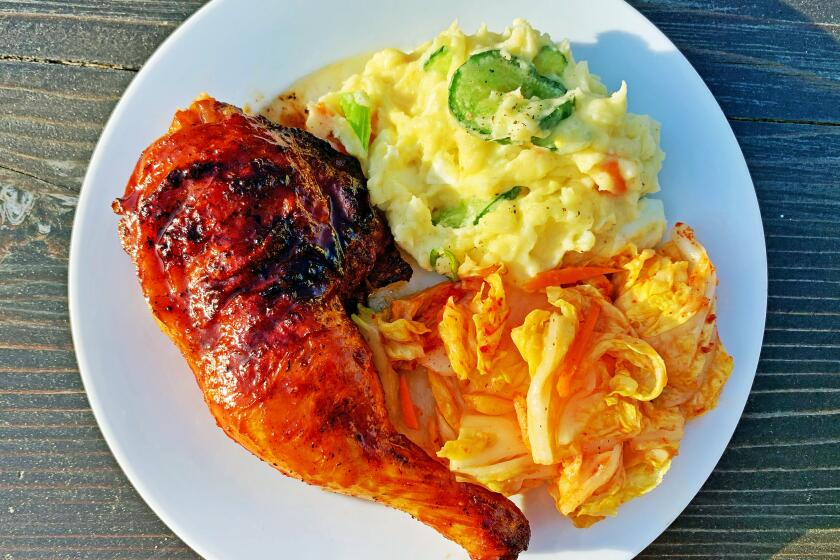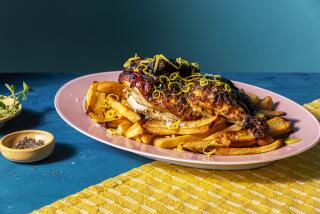How to grill chicken so it’s juicy with charred (not burned!) skin

- Share via
I grill bone-in chicken the way the tortoise runs the race against the hare in Aesop’s fable: slow and steady. Cooking this way over moderate heat ensures a winning chicken dinner. If you start out too fast and set the chicken over intense heat to try to grill it quickly, you’ll end up with burned skin and raw meat. It’s a losing move.
There are some who like to char the skin over direct high heat and then finish cooking over indirect low heat. I’ve found that the initial too-hot flames leave an acrid burned taste on the outside and rubbery meat inside. Keeping the temperature not-too-hot results in burnished skin with a pleasant smokiness and juicy meat that tastes great on its own or with a range of marinades and glazes. (And grilling takes only 30 minutes or so.) To achieve it, follow these basic steps:
-Use bone-in skin-on chicken. The skin protects the meat from drying out and, with the bone, adds a ton of flavor. Plus, this method doesn’t work with boneless, skinless chicken, which should be grilled fast over high heat.
-Take the chill off. Remove the chicken from the refrigerator and let it hang out at room temperature while the grill heats. If the chicken is too cold when it hits the hot grill, the meat will tighten and end up tough and may stay cold and raw near the bone even after the rest of it is beautifully cooked.
-Marinate for extra deliciousness. You don’t have to marinate, but if you do, you’ll be rewarded with more flavorful meat. I marinate at room temperature while the grill heats up. It’s enough time to season the meat (over-soaking chicken in acidic marinades can make the texture mushy). If you want to skip marinating, sprinkle the chicken generously with kosher salt instead before letting it sit at room temperature.
-Make sure the grill is the right temperature. You want moderately high heat that registers 400 degrees on a built-in thermometer when the cover is closed. Turn the dials on a gas grill between the highest and middle settings. On a charcoal grill, spread the ashed-over coals in an even layer. The coals are ready when you can hold your hand an inch above the grate for 3 seconds before instinctively pulling away.
-Prep the chicken skin. Right before you put the chicken on the grill grate, wipe off any excess marinade then pull the chicken skin taut over the meat to cover it as much as possible. If there’s extra skin on thighs (lucky you!), wrap it over the skinless parts. This will help the skin brown evenly and keep the meat under it more tender. Set the chicken on the hot grate skin side down.
-Don’t move the meat. Cover the grill, opening the top vents on a charcoal grill. In this first stage of cooking, you want the skin to go deep golden brown. When it’s ready, it will naturally release from the grate. If it starts to brown too quickly, reduce the heat. If you try to flip it and it clings to the grate, let it sit longer.
-Test the meat. After flipping the chicken, cook it skin side up until the meat is almost cooked through if you’re going to glaze it and fully cooked if not. To test its doneness, slip a sharp paring knife near the bone. It should slide in and out easily and the blade should feel hot. Any juices that run out should be clear. If you have an accurate meat thermometer, the meat near the bone should register 160 degrees for bone-in breasts and 165 degrees for dark meat.
-Glaze evenly and finish cooking. If you’re glazing the chicken with sauce, brush the skin with a generous layer when the meat’s almost cooked through (155 degrees for breasts; 160 for legs). Flip it and brush the other side. Keep glazing and brushing with a steady rhythm until the chicken has a caramelized coat of sauce.
-Wait for it. By the time you pull the chicken off the grill, you’re going to be drooling over its smoky scent. But resist the temptation to tear into it right away. Let the chicken rest on the platter uncovered for five minutes or so before serving. This will make the meat juicier and let the glaze infuse its flavor.
These tips apply to any grilled bone-in chicken, dark or white, marinated or glazed or not. You can start by trying this gochujang-glazed grilled chicken, which combines a quick garlicky lemon-soy marinade with a spicy-sweet glaze. A final drizzle of sesame oil adds another layer of richness. When all those seasonings mingle together on the platter while the chicken rests, they become a delicious sauce for the chicken and sides of steamed rice or potato salad.
Gochujang Glazed Grilled Chicken
More to Read
Eat your way across L.A.
Get our weekly Tasting Notes newsletter for reviews, news and more.
You may occasionally receive promotional content from the Los Angeles Times.












